For the modern worker, professional stability is losing its luster. As a rich body of research asserts, employees are now moving between companies at an unprecedented pace. Millennials are particularly attuned to opportunities elsewhere, departing for new gigs more often than their elders. In a historically tight labor market, turnover represents a major financial threat for employers. In many cases, hiring costs actually exceed a given worker’s salary – not to mention the inevitable drag on morale and productivity.
How long do most workers intend to stay with their current employers – and what eventually lures them away? To study these questions, we surveyed approximately 1,000 professionals about their opinions and plans regarding jumping between jobs. Our findings present the factors that precipitate employment changes and reveal the financial trajectories employees experience throughout their careers. To learn how committed employees truly are to their companies, follow along!

Intended Tenures
In some corners, millennials have been branded habitual job-hoppers, constantly on the hunt for new opportunities. Our findings don’t dispel this notion. Among workers in their 20s, 83% had held two or more jobs in the last five years. Conversely, older workers were more likely to be settled in their roles. Among workers aged 50 and older, for example, 70% had held just one job over the last five years.
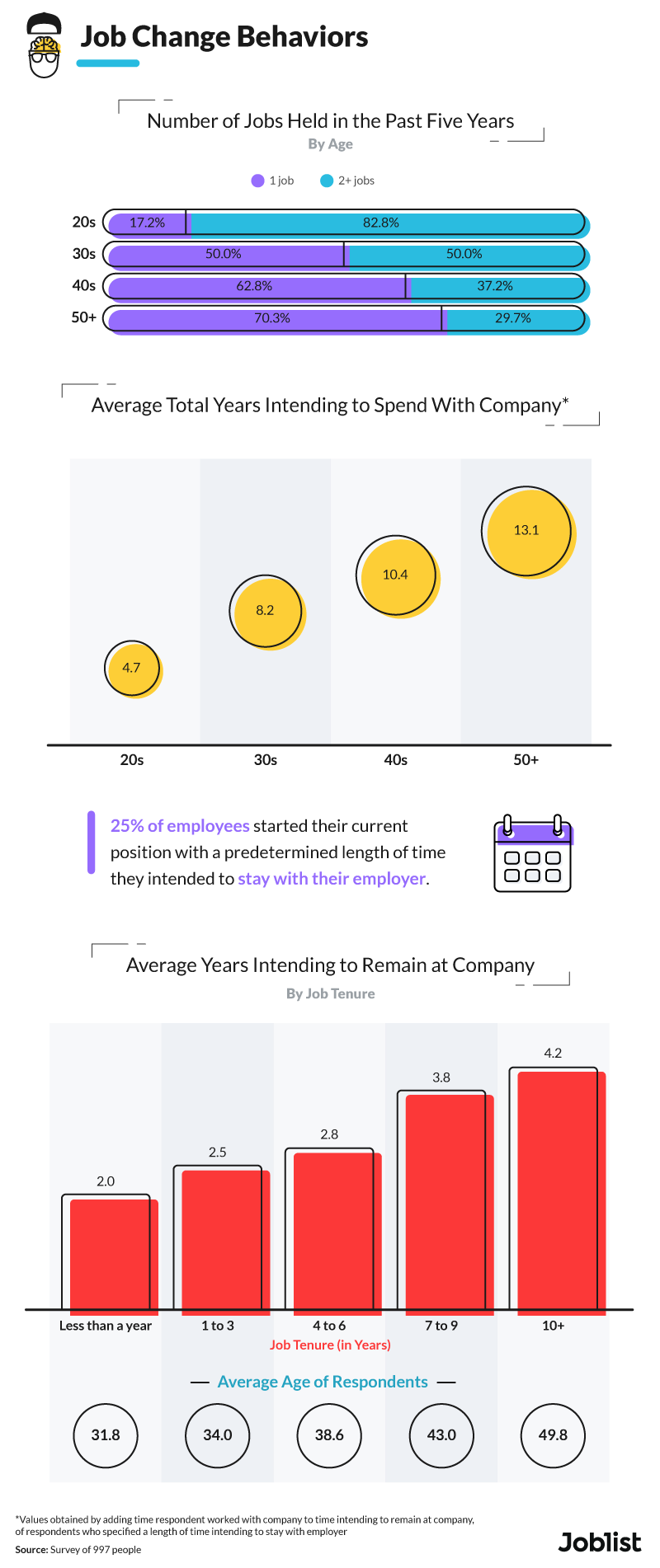
While these trends could be attributed to the stigmatizing perception that millennials have an aversion to commitment, many researchers say job-hopping simply reflects their youth. Indeed, some data suggests that Gen Xers were just as likely to jump between jobs in their 20s, an age typically associated with employment experimentation.
Interestingly, our findings suggest a relationship between job tenure and and an employee’s perceptions of how many more years they intend on staying with their company. Employees who had been working at their companies under a year only saw themselves working for their employers for 2 more years, a value that slowly climbed the longer a person had already been working at their company.
This may be the natural result of people spending longer periods of time at desirable employers, and that their satisfaction with these employers influences how much longer they would like to remain with them into the future. Alternatively, this pattern may reflect complacency employees develop the longer they remain in one phase of their careers.
Lured Into Looking
For this project, we divided respondents into two groups: frequent job-hoppers who had held two or more jobs in the past five years, and infrequent job-hoppers who had just one job during the same period. For both camps, the top reason to consider another job was clear. People want increased compensation. In a historically tight labor market, a record number of workers are departing their jobs in pursuit of bigger paychecks. Yet, employees weren’t willing to jump ship for just any pay bump. On average, professionals wanted a raise of $15,491, or a 25% increase to our respondents’ average salary.
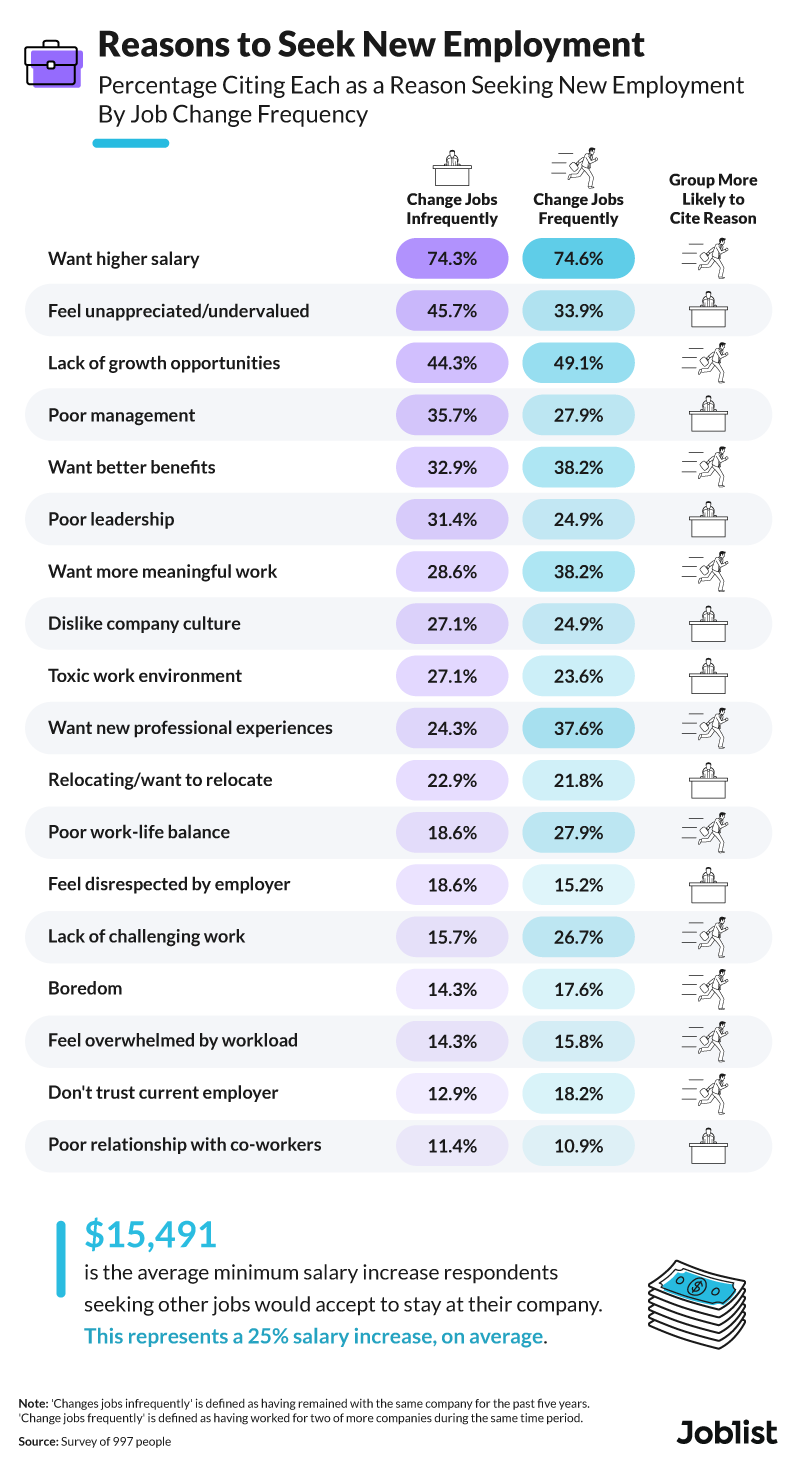
Beyond money, frequent and infrequent job-changers voiced somewhat different motivations for considering job changes. Frequent job-hoppers were far more likely to say lack of growth opportunities or meaningful work would propel them to leave; researchers suggest these intangibles are especially important to millennials. By contrast, those who stayed at their jobs long term were more likely to say they’d seek new opportunities due to issues involving their bosses, such as poor management, poor leadership, or feeling underappreciated.
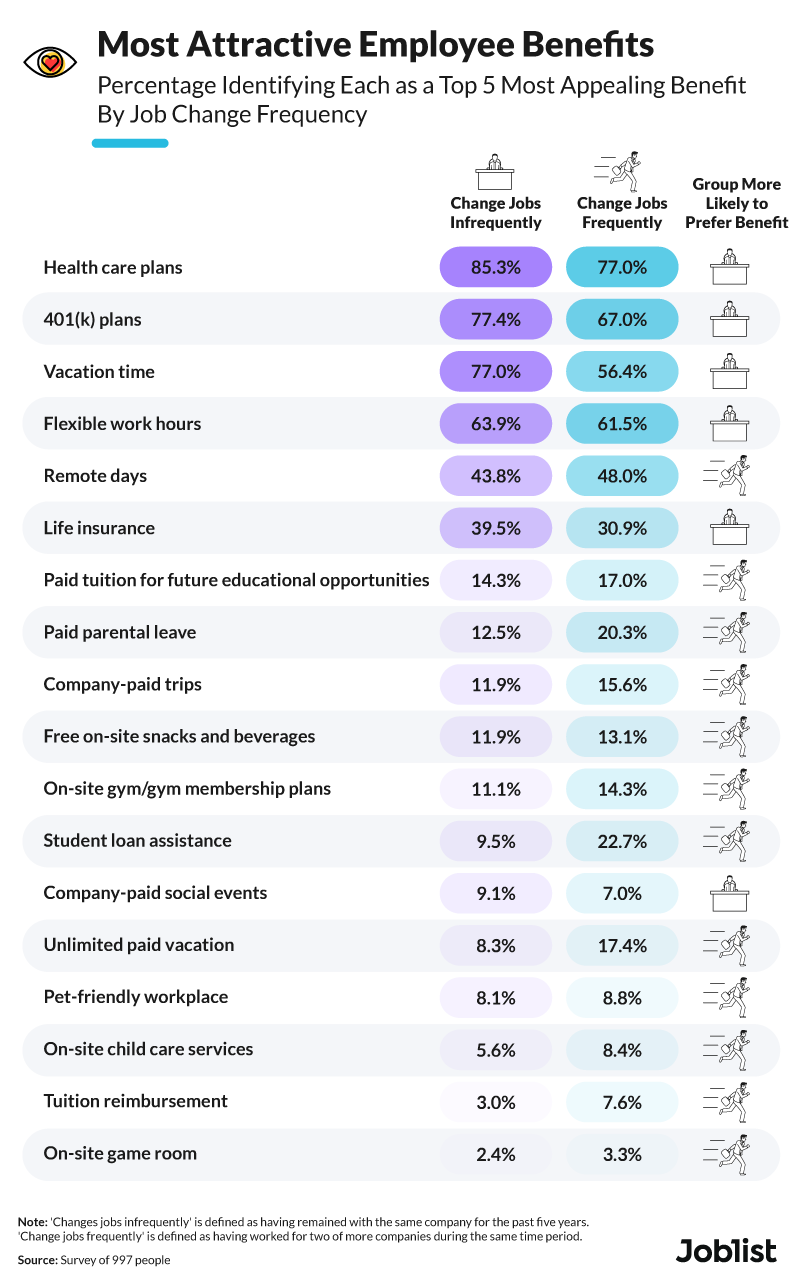
Additionally, infrequent job-changers placed greater emphasis on an array of benefits, including health insurance, 401(k) options, and vacation time – perhaps due to being older. Frequent job-hoppers showed greater interest in more novel perks, such as unlimited paid vacation days and student loan assistance. Once again, generational differences seem relevant. For millennials saddled with significant student loan debt, help with student loans can be a substantial perk.
Income Incentives
For workers looking to maximize their earnings, is changing jobs a wise move? Experts suggest that job changes entail a trade-off. While employees can earn significantly more overnight, a record of swift job changes could scare away future employers. According to our results, the pay bump associated with changing jobs is often quite modest.
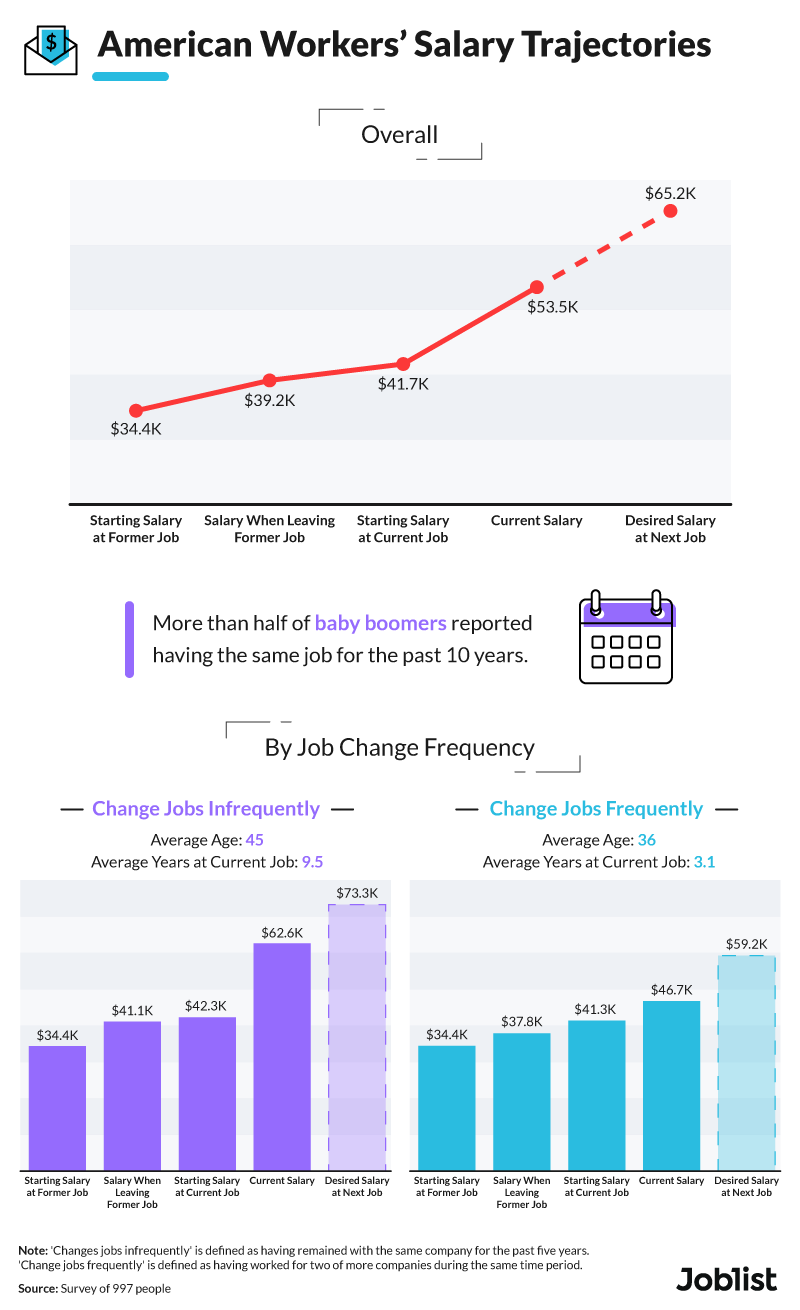
On average, respondents reported that when they started their current job, they earned $2,500 more per year than at their previous position. The average increase was higher among frequent job-hoppers by over $3,000. In contemplating their next moves, however, most workers set their sights far higher, both aiming for over $10,000 more in a subsequent role.
Infrequent job-changers earned more, on average, than their job-hopping counterparts, and their incomes increased more significantly during their time with their current employer. These statistics likely reflect age differences and experience. However, infrequent job-hoppers were nine years older, on average, than job-hoppers and, thus, were more likely to be in their peak earning years. Accordingly, it’s possible that job-hoppers may earn more throughout their careers, especially if they eventually settle into lucrative positions.
Commitment and Conduct
Are frequent job-changers less effective employees? One might assume so. Workers eyeing other opportunities could be less engaged daily. On the other hand, long-term employees could also be less motivated, becoming complacent in their current roles.
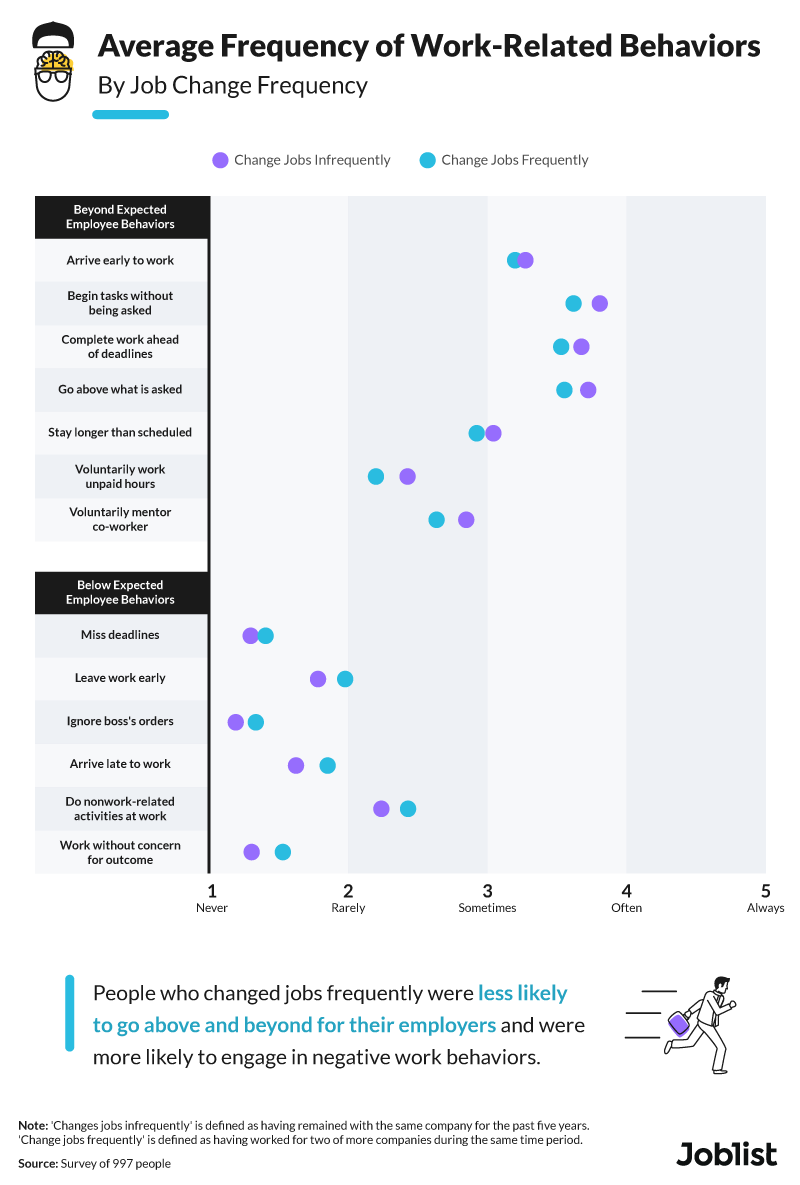
Long-term employees were slightly more likely to demonstrate an array of positive behaviors at work than job-hoppers. The gap was greatest in terms of nonobligatory behaviors, such as voluntarily putting in unpaid hours, mentoring a co-worker, or going above and beyond what is asked. These behaviors may be hard to quantify but represent some of the most crucial upsides of retaining veteran team members.
By the same token, job-hoppers were more likely to engage in counterproductive behaviors, such as leaving work early or arriving late. Additionally, they were more likely to work without being invested in the outcome – after all, the ramifications of failure might not affect them at their next gig. Research suggests that a stunning percentage of Americans feel disengaged from their work. Are they detached because they’re considering other jobs or vice versa?
Opportunity and Community
Employers may find cause for concern in our findings: a rising generation of workers seems less devoted to developing their career with their current organization and are more willing to seek opportunities elsewhere. Yet, our results also indicate important ways to retain talent – beyond simply offering competitive compensation.
Indeed, a significant portion of workers seeks certain intangibles from their employers, such as chances to take on new responsibilities and the appreciation of one’s managers. To avoid a bidding war to retain top employees, companies would do well to invest in these dimensions of company culture. The wisest retention strategy may be creating a sense of shared possibility. When we feel we’re building something with our colleagues, we’re less likely to leave them behind.
Whether you’re searching for your next role or seeking employees worth keeping, Joblist is here to aid your endeavors. With millions of jobs updated daily and personalized results to match candidates and employers, we create professional connections built to last.
Methodology
We collected responses from 997 American participants who reported currently having full-time jobs. Of the respondents, 42.4% were millennials, 33.7% were from Generation X, 20% were baby boomers, and 3.9% belonged to Generation Z. The average age was 40.3 with a standard deviation of 12 years.
Limitations
The survey results were self-reported and are, therefore, subject to self-reporting and acquiescence biases such as telescoping and exaggerated responses.
Fair Use Statement
Maybe you know someone who might be interested in our findings, such as a friend in search of a new opportunity or a colleague eyeing a position elsewhere. If so, you’re welcome to share our images and information (for any noncommercial purpose, of course). We simply ask that you include a link back to this page whenever you share our work so that others can explore our project in full.





